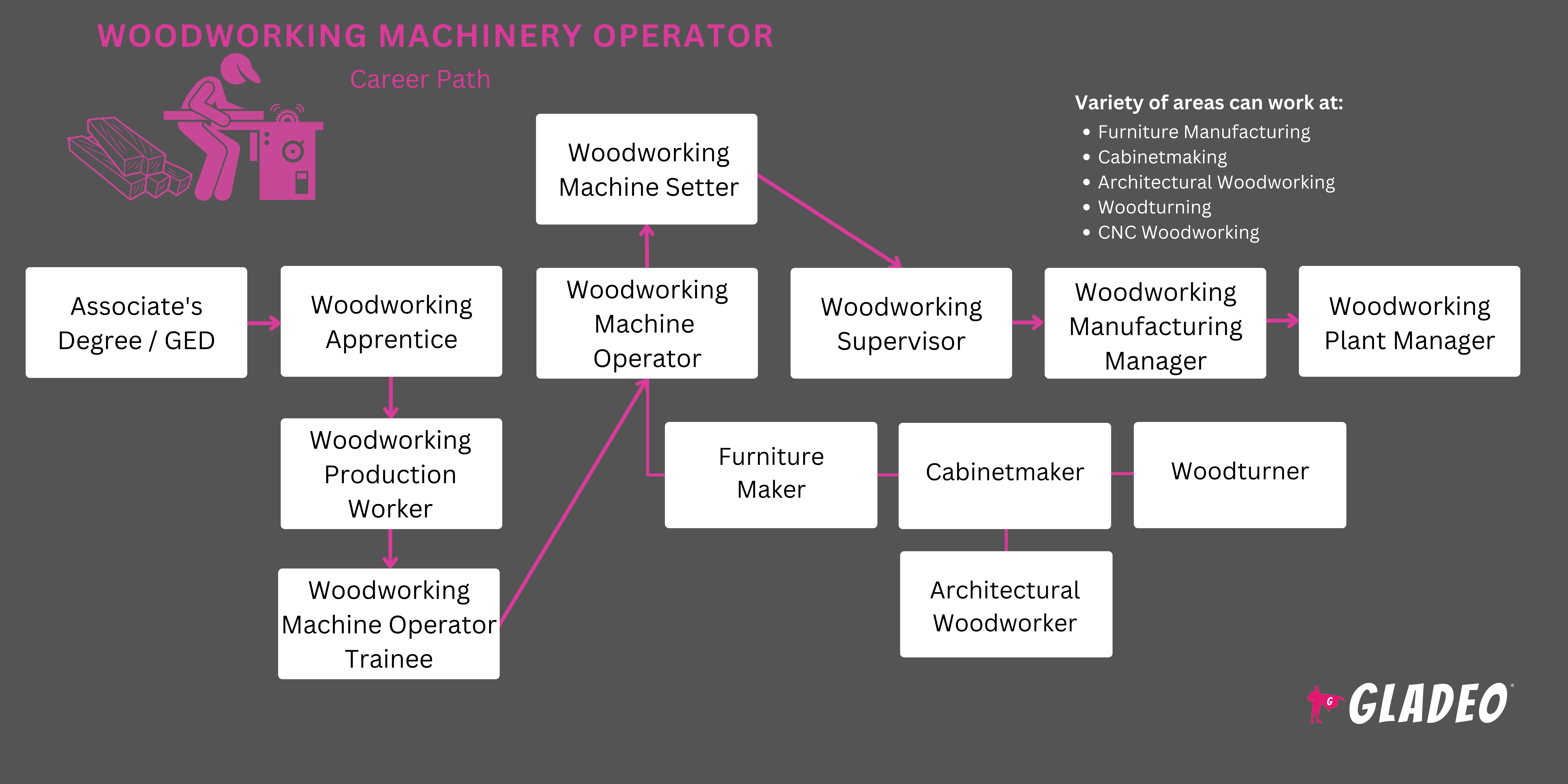聚光灯
镗床操作员、橱柜制造员、绳结锯操作员、车床操作员、机械操作员、成型机操作员、刳刨机操作员、砂光机、砂光机操作员
Humans have been making things out of wood for almost as long as we’ve existed! Wood is abundant, sturdy, and useful for a wide range of things. But it wasn’t until we invented saws and other cutting instruments that woodworking really took off!
Today, we have an array of powered machinery to cut, smooth, and shape wood for furniture, cabinets, and other products. But it takes highly trained Woodworking Machinery Operators to use these types of equipment to craft raw wood into finished pieces or parts.
From band and circular saws to drill presses, lathes, and milling machines, they must be proficient in safe machinery operation techniques to avoid any mishaps while they work! In addition, they have to understand the properties of the wood they’re working on. They frequently collaborate with designers and craftsmen to understand the exact requirements for the items they’re going to produce.
- Creating tangible, often artistic wood products
- Steady work in furniture, construction, and custom woodwork industries
- Independence to work on pieces at individual workstations
工作日程
- Woodworking Machinery Operators typically work full-time, and must frequently travel to job sites. They may work overtime when collaborating with construction teams on larger projects.
典型职责
- Review project drawings, blueprints, or schematics
- Set up manual and Computer Numerically Controlled (CNC) woodworking machines, such as drill presses, lathes, shapers, routers, sanders, planers, and wood-nailers
- Program basic instructions into computerized machines using G-code, computer-aided manufacturing (CAM) software, or machine-specific programs
- Examine woodstock to make sure it conforms to requirements
- Position wood pieces correctly and securely before working on them
- Operate machines safely, according to manufacturer instructions
- Monitor machine operations for problems or signs of instability, such as excessive vibration. Adjust controls as needed to ensure proper performance
- Use hand tools as needed to put the finishing touches on products
- Check finished workpieces to ensure quality (including the correct shape, smoothness, and other specifications). Use measuring instruments such as rules, calipers, templates, and gauges
额外责任
- Conduct routine maintenance on woodworking machinery (i.e., cleaning, oiling, and replacing old parts)
- Wear proper personal protective equipment such as goggles, gloves, masks, or hearing protection
- Train and mentor new operators
- Maintain a clean workstation
- Document work procedures, as required
软技能
- Accuracy
Alertness - 分析性的
- 谨慎
- 以合规为导向
- 批判性思维
- 注重细节
- 纪律
- 出色的手眼协调能力
- 手动灵活性
- 监测
- 没有严重的粉尘过敏或呼吸问题
- 耐心
- 规划和组织
- 解决问题
- 质量保证
- 具有安全意识的
- 健全的判断力
- 劲力
- 强大的沟通能力
- 时间管理
技术技能
- Machinist programs like Machinist’s Calculator
- Computer-aided design programs like Autodesk AutoCAD
- Computer-aided manufacturing software like Autodesk Fusion 360
- Industrial control software such as EditCNC
- Procedure management programs
- Tools and equipment such as micrometers, vernier calipers, lathes, milling machines, shapers, grinders, drilling machines, cutting tools, etc.
- Fundamental knowledge of hydraulic systems, electrical wiring, lubricants, and batteries (for portable or cordless tools)
- Familiarity with various types of wood
- Personal protective equipment (PPE)
- Furniture and related product manufacturing
- Wood product manufacturing
- Self-employed workers or contractors
Woodworking Machinery Operators are relied on to produce products that conform to very specific requirements. Thus their work must be meticulous, even under pressure to meet deadlines.
They have to take into consideration multiple factors, including what types of wood can be used with which types of equipment, and how best to cut or shape the wood.
The working environment can be loud and hazardous, requiring workers to wear protective gear, such as goggles and hearing protection. They must carefully follow safety procedures to avoid injury to themselves or others in the area.
The day-to-day job requires stamina because workers are usually on their feet, often in bent or leaning positions. The repetition can get monotonous after a while, but workers have to keep their focus because of the inherent risks of the job so they don’t get hurt!
The woodworking industry is increasingly embracing automation and CNC technology, significantly enhancing precision and productivity! CNC routers and lathes are helping to facilitate more complex designs, transforming the sector into a more efficient, versatile field.
Alongside technological advancements, there’s also a growing emphasis on sustainability. Customers have more focus on eco-friendly materials and practices in general, such as buying products made from recycled wood or responsibly sourced timber.
Another trend is thanks to the advancements in software like CAD and CAM, which are not only revolutionizing design and production processes but also streamlining operations.
People who get into machine-related career fields usually enjoy working with their hands and feel comfortable using tools and stationary heavy equipment. They might have enjoyed math and computer programming courses in high school or liked doing projects in shop classes.
Woodworking Machinery Operators can collaborate with others but don’t mind being on their own for long periods. They might have been very independent growing up and may have always wanted a job where they have some freedom to do their work without a lot of interaction with others.
- Woodworking Machinery Operators need a high school diploma or equivalent. A college degree is not necessary
- Workers must have applicable woodworking, carpentry, or construction skills. These can be learned in high school, via vocational courses, apprenticeships, or part-time jobs
- Some start as helpers or laborers, learning how to safely use hand and power tools before moving on to larger equipment like CNC machines
- Operators may need to program their CNC machines, so having some knowledge of basic computer applications is useful
- In addition, certain types of math are commonly used in this profession, such as basic arithmetic, geometry, fractions and decimals, measurement conversions, basic algebra, trigonometry, and proportions and ratios
- Operators can apply for credentials from the Woodwork Career Alliance of North America such as:
- Sawblade Certificate: Focuses on introducing fundamental woodworking skills and safety knowledge
- Green Credential: Covers basic woodworking operations and safety practices
- Blue Credential: Involves advanced skills and knowledge in woodworking techniques and machinery operation
- Red Credential: For demonstrating proficiency in a range of woodworking machinery and techniques
- Gold Credential: Represents a high skill level in woodworking, encompassing advanced machinery operation and complex techniques
- Diamond Credential: Indicates mastery of woodworking skills and extensive experience in the industry
- Workers also may benefit from obtaining CNC machine certification via community colleges and directly from machine manufacturers!
- Safety is an integral part of the job, so an OSHA Safety and Health
Fundamentals Certificate or OSHA 10-hour training card can be helpful. Employers can usually explain the details and help workers get signed up!
- Woodworking Machinery Operators don’t need to go to college, but if you do take classes, consider the cost of tuition, discounts, and local scholarship opportunities (in addition to federal aid)
- Think about your schedule and flexibility when deciding whether to enroll in an on-campus, online, or hybrid program. Ideally, you’ll want as much hands-on practice as you can get for many of these courses
- Read reviews from previous students and check out job placement stats and details about the program’s alumni network
- Note, some training programs may have connections with local employers!
- Woodworking Machinery Operators should take art/design, blueprint reading, general math (arithmetic, fractions, decimals, ratios, proportions), geometry, drafting, computer-aided design, basic computer programming, and woodworking or shop courses
- Gain hands-on skills under the supervision of a professional who can show you how to use hand and power tools safely
- High school students can often take community college or vocational training classes simultaneously. Your school counselor should be able to offer details
- Get practical work experience through part-time carpentry or construction jobs (or via apprenticeships or entry-level laborer positions)
- 从Coursera、Udemy 或其他网站在线学习临时课程
- Watch related videos on YouTube channels like WOOD magazine and Rob Cosman
- Educate yourself through relevant books, magazines, blogs, and discussion forums
- Ask a working Woodworking Machinery Operator if they have time to do an informational interview with you
- 参与专业组织,学习、分享、交朋友,并扩大你的网络(见我们的资源清单>网站)。
- 尽早开始制作一份简历。一边做一边补充,这样你就不会失去任何东西。
Note, that many employers in the skilled trades, including machine operations, conduct pre-employment drug tests. This is because the use of machines and tools can be hazardous, so employers and insurance companies want to reduce risks. For apprenticeships, unions may mandate pre-apprenticeship drug tests or random drug tests.

- Rack up as much relevant experience as you can in school or through volunteer work, part-time jobs, or an apprenticeship
- Check out job portals like Glassdoor, Indeed, USAJOBS, or SimplyHired
- Screen job ads carefully to ensure you meet the requirements
- Focus your resume on relevant work and academic experiences
- Review Woodworking Machinery Operator resume templates to get ideas for formatting and phrasing
- 在简历/申请中加入关键词,例如
- Assembly Techniques
- 蓝图阅读
- CAD Software
- CNC Machining
- Machine Operation
- Maintenance Procedures
- Material Handling
- OSHA 标准
- Precision Measuring
- Production Scheduling
- Quality Control
- 安全协议
- Technical Documentation
- Tool Calibration
- Wood Finishing
- Woodworking Machinery
- 在Apprenticeship.gov上寻找学徒机会
- Ask your school’s career services staff for help with resumes, mock interviews, and job searches
- Also, ask for help connecting with recruiters and job fairs. They may even have connections to local unions that offer apprenticeships!
- If applying for a union apprenticeship, read the application instructions carefully before filling anything out. Note, “most unions don’t expect you to be an expert in your industry,” when you apply for an apprenticeship,” notes Indeed
- Reach out to your network to let them know you are looking for opportunities
- 提前询问潜在的推荐人,看他们是否会推荐你或写推荐信
- 参与在线论坛并提出职业咨询问题
- 查找常见面试问题,为关键面试做好准备
- At interviews, be honest and show a motivated attitude and eagerness to learn
- 要想面试成功,着装一定要得体!
- Be ready to meet pre-employment requirements
- Woodworking Machinery Operators can work their way up by doing consistently high-quality work, paying attention to details, being on time and ready every day, and getting projects finished on time and on budget
- Talk to your supervisor about your career goals. Let them know you are willing to knock out any training your employer suggests, such as specialized certifications
- Ask about tuition reimbursement or other employer-sponsored educational benefits to cover your expenses as you continue learning about the trade
- 挑战自我,参与更复杂的项目
- Always prioritize safety and never take shortcuts. One significant mishap or injury could damage your whole career!
- Demonstrate that you can be trusted to work independently. Set the example for others to follow
- 研究制造商和软件指南。成为首选专家,使自己成为无价之宝
- Learn all you can from those with more experience (but also keep in mind to follow procedures as directed by your employer)
- Collaborate effectively on teams, stay focused, and demonstrate
leadership. Keep your cool under pressure, and treat everyone with respect! - Train new workers thoroughly. Their mistakes could reflect on your training abilities
- Stay engaged with professional organizations and unions
网站
- Apprenticeship.gov
- 建筑木工研究所
- 制造技术协会
- Association of Woodworking & Furnishings Suppliers
- 职业联系
- Carpenters Southwest Administrative Corporation
- 木匠培训学院
- 国际制造商协会
- Family Handyman Magazine
- Fine Woodworking Magazine
- 从头盔到防护帽
- International Woodworking Fair
- 就业指导中心
- More Woodturning Magazine
- 全国建筑业工会
- 国家工具和加工协会
- NCCER
- Popular Woodworking Magazine
- Practical Machinist
- Scroll Saw Woodworking and Crafts
- ShopNotes
- Sisters in the Brotherhood
- This Old House Magazine
- 美国木匠和木工联合兄弟会
- United Brotherhood of Carpenters and Joiners of America, Carpenters Training Fund
- Western States Carpenters
- Woodcarving Illustrated
- Wood Component Manufacturers Association
- Woodcraft Magazine
- Wood Industry Ed
- 木材工业资源协作组织
- Wood Magazine
- Woodsmith
- 北美木工职业联盟
- Woodworker’s Journal
书籍
- Machinists’ Ready Reference, by C. Weingartner and Jim Effner
- Mastering Woodworking Machines (Find Woodworking), by Mark Duginske
- Woodworking: The Complete Step-by-Step Manual, by DK
- Woodworking Basics - Mastering the Essentials of Craftsmanship - An Integrated Approach With Hand and Power Tools, by Peter Korn
- Woodworking Bible: Discover Essential Tools and Equipment to Set Up Your Homebased Workshop. Follow Step-By-Step Techniques to Create Over 50 DIY Plans and Projects, by DIY Academy
Woodworking in general is becoming more automated these days, but overall the job outlook seems stable according to the Bureau of Labor Statistics. Still, if you want to explore other options, below are several more occupations to consider!
- 锅炉工
- Building Maintenance Worker
- 卡朋特
- 计算机程序员
- 建筑工人
- 切割、冲压和压力机操作员
- 干墙安装工
- 地板安装工
- Forging Machine Operator
- Furniture Assembler
- 工业机械技师
- 绝缘工人
- 铁工
- 珠宝商
- Lathe and Turning Machine Tool Operator
- Machinist/Tool and Die Maker
- 铣床和刨床操作员
- Renovation Specialist
- Rolling Machine Operator
- 屋顶工人
- 金属板工人
- 太阳能光伏安装人员
- 金属结构制造和装配工
- Textile Cutting Machine Operator
- 瓷砖和石材镶嵌工
- 焊工
新闻联播

特色工作

在线课程和工具








